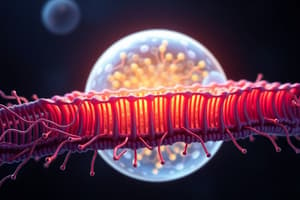Podcast
Questions and Answers
What is selective permeability in relation to cell membranes?
What is selective permeability in relation to cell membranes?
- The ability to allow only certain molecules to enter or exit the cell (correct)
- The ability to trap all substances within the cell
- The ability to regulate temperature within the cell
- The ability to rapidly transport all available substances in and out of the cell
During osmosis, water moves from an area of _ concentration of solute to an area of _ concentration of solute.
During osmosis, water moves from an area of _ concentration of solute to an area of _ concentration of solute.
- high, low
- low, high (correct)
- equal, unequal
- none of the above
In which type of solution will cells lose water and potentially shrivel?
In which type of solution will cells lose water and potentially shrivel?
- Hypertonic (correct)
- Isotonic
- Isobaric
- Hypotonic
What is the primary method by which water moves through a cell membrane?
What is the primary method by which water moves through a cell membrane?
What is required for active transport to occur?
What is required for active transport to occur?
What happens to plant cells when placed in a hypotonic solution?
What happens to plant cells when placed in a hypotonic solution?
Facilitated diffusion involves the transport of materials across a cell membrane by:
Facilitated diffusion involves the transport of materials across a cell membrane by:
What type of transport occurs when materials move across the membrane without using energy?
What type of transport occurs when materials move across the membrane without using energy?
Flashcards
Selective Permeability
Selective Permeability
The cell membrane acts as a gatekeeper, allowing only certain substances to pass through while blocking others.
Diffusion
Diffusion
The movement of particles from an area with a high concentration to an area with a low concentration. This movement is random and doesn't require any energy from the cell.
Osmosis
Osmosis
Diffusion of water across a selectively permeable membrane. Water moves from areas of high water concentration (low solute concentration) to areas of low water concentration (high solute concentration).
Isotonic Solution
Isotonic Solution
Signup and view all the flashcards
Hypertonic Solution
Hypertonic Solution
Signup and view all the flashcards
Hypotonic Solution
Hypotonic Solution
Signup and view all the flashcards
Passive Transport
Passive Transport
Signup and view all the flashcards
Facilitated Diffusion
Facilitated Diffusion
Signup and view all the flashcards
Study Notes
Selective Permeability
- The cell membrane controls what enters and exits the cell.
Diffusion
- Movement of particles from high to low concentration.
- This movement is random, particles collide, and spread out.
- Results in particles evenly distributed (dynamic equilibrium)
Osmosis
- Diffusion of water across a selectively permeable membrane.
- Water moves from low to high solute concentration.
- Water uses aquaporins (water channel proteins).
- Water moves until dynamic equilibrium is reached.
Types of Water Solutions
Isotonic Solutions
- Solute concentration is the same inside and outside the cell.
- Example: Medicines
Hypertonic Solutions
- Solute concentration is higher outside the cell than inside.
- Water moves out of the cell.
- Cell shrinks (plasmolysis) due to decreased pressure.
- Examples: Dry meat, raisins
Hypotonic Solutions
- Solute concentration is lower outside the cell than inside.
- Water moves into the cell.
- Cell swells.
- Internal pressure increases.
Studying That Suits You
Use AI to generate personalized quizzes and flashcards to suit your learning preferences.



